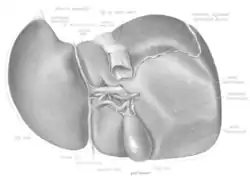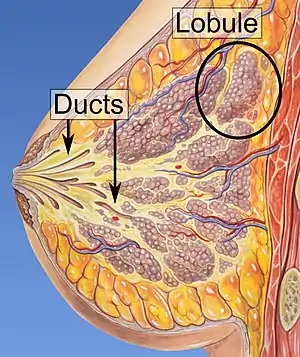Lobe (anatomy)
In anatomy, a lobe is a clear anatomical division or extension[1] of an organ (as seen for example in the brain, lung, liver, or kidney) that can be determined without the use of a microscope at the gross anatomy level. This is in contrast to the much smaller lobule, which is a clear division only visible under the microscope.[2]
| Lobes | |
|---|---|
 Visceral surface of the liver showing the four lobes | |
| Identifiers | |
| TA98 | A13.1.02.002 |
| FMA | 45728 |
| Anatomical terminology | |
Interlobar ducts connect lobes and interlobular ducts connect lobules.
Examples of lobes
- The four main lobes of the brain
- the frontal lobe
- the parietal lobe
- the occipital lobe
- the temporal lobe
- The three lobes of the human cerebellum
- the flocculonodular lobe
- the anterior lobe
- the posterior lobe
- The two lobes of the thymus
- The two and three lobes of the lungs
- Left lung: superior and inferior
- Right lung: superior, middle, and inferior
- The four lobes of the liver
- The renal lobes of the kidney
- Earlobes
Examples of lobules

Lobules of the mammary glands.
- the cortical lobules of the kidney
- the testicular lobules of the testis
- the lobules of the mammary gland
- the pulmonary lobules of the lung
- the lobules of the thymus
References
- "Types of lobes". eMedicine Dictionary. Archived from the original on 27 September 2017.
- "Histology of Glands". Southern Illinois University (SIU), Carbondale, Illinois. Archived from the original on 25 April 2022. Retrieved 25 April 2022.
This article is issued from Wikipedia. The text is licensed under Creative Commons - Attribution - Sharealike. Additional terms may apply for the media files.